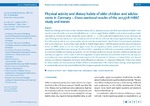Physical activity and dietary habits of older children and adolescents in Germany – Cross-sectional results of the 2017/18 HBSC study and trends
Bucksch, Jens
Häußler, Angela
Schneider, Katja
Finne, Emily
Schmidt, Katrin
Dadacynski, Kevin
Sudeck, Gorden
Numerous findings are known to exist between dietary habits, physical activity, and child and adolescent health. Here,
we will use data from the most recent Health Behaviour in School-aged Children (HBSC) study to describe dietary habits
and patterns of physical activity. Using the survey data for 11-, 13- and 15-year-old students from across Germany, we
report findings for key indicators of diet and physical activity for the 2017/18 cycle. By comparing these findings with data
from the 2009/10 and 2013/14 survey cycles, we also consider current trends. Results from the most recent cycle show
that 10.0% of girls and 16.9% of boys meet the World Health Organization’s (WHO) physical activity recommendations.
Across all HBSC cycles, this is the lowest figure so far. Concerning dietary habits, 50.6% of girls and 59.0% of boys
reported having breakfast every morning. Data for daily fruit, vegetable and soft drink consumption emphasises the need
to promote a healthy diet among adolescents. For all indicators of physical activity and diet, differences between girls
and boys are apparent. Girls’ intake of fruit and vegetables is higher and they consume fewer soft drinks, yet boys are
more physically active and have breakfast more regularly. For the majority of indicators of dietary habits and physical
activity, considerable inequalities relating to family affluence are observed. An important implication of the study results
for dietary habits and physical activity of older children and adolescents is the need to foster settings-based approaches
to promote physical activity and a healthy diet that integrate a gender-sensitive perspective.
Dateien zu dieser Publikation
Keine Lizenzangabe

